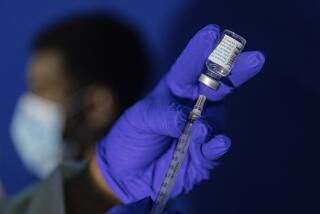CDC: Ebola cases could go as high as 1.4 million by late January
In a grim assessment of the Ebola epidemic, researchers say the deadly virus threatens to become endemic to West Africa instead of eventually disappearing from humans.
“The current epidemiologic outlook is bleak,” wrote a panel of more than 60 World Health Organization experts in a study published Tuesday by the New England Journal of Medicine.
“We must therefore face the possibility that Ebola virus disease will become endemic among the human population of West Africa, a prospect that has never previously been contemplated.”
In the absence of new control measures, the authors estimated that the total case load would exceed 20,000 by Nov 2.
“The numbers of cases of and deaths from EVD are expected to continue increasing from hundreds to thousands per week in the coming months,” the authors wrote.
As of Monday, the United Nations health organization reported that out of a total of 5,864 confirmed and probable cases, 2,811 deaths have resulted.
“The true numbers of cases and deaths are certainly higher,” the authors wrote. “There are numerous reports of symptomatic persons evading diagnosis and treatment, of laboratory diagnoses that have not been included in national databases, and of persons with suspected Ebola virus disease who were buried without a diagnosis having been made.”
Between 550,000 and 1.4 million people in West Africa could be infected with the Ebola virus by January 20, 2015, according to a report issued on Tuesday by the U.S. Centers for Disease Control and Prevention (CDC).
The top range of the estimate, 1.4 million, assumes that the number of cases officially cited so far is significantly underreported, and that it is likely that 2.5 times as many cases, or nearly 20,000, have in fact occurred.
CDC emphasized that the projections, based on an epidemiological model that takes into account how many people each Ebola patient eventually infects as well as other factors, is based on data available in August. They therefore do not account for the recently announced U.S. government Ebola relief effort, which includes sending 3,000 members of the armed forces to the Ebola-stricken region.
“Extensive, immediate actions -- such as those already started -- can bring the epidemic to a tipping point to start a rapid decline in cases,” CDC said in a statement.
When a virus is slow to mutate, as Ebola appears to be, the pathogen steadily wanes as the number of people who have developed immunity increases. With proper controls, experts say the virus would find it increasingly difficult to spread among the population until it eventually disappeared from humans and survived only in its so-called animal reservoir, which is believed to be a fruit bat.
In this case however, epidemiologists fear that the virus could continue to linger in small pockets, extending its life in humans and potentially mutating in a way that makes fighting it more difficult.
In the WHO paper, researchers presented their first, full statistical snapshot of the epidemic, which gained a foothold in December of last year and has fallen hardest on Guinea, Liberia and Sierra Leone.
The majority of patients stricken by Ebola are 15 to 44 years old, with men and women suffering at a nearly equal rates, according to researchers. The case fatality rate -- based on confirmed cases only -- is 70.8%, with a slightly lower chance of death -- 64.3% -- for those admitted to a hospital.
Although the epidemic has already killed more people than all previous outbreaks combined, researchers said the virus now wreaking havoc on some of the world’s poorest nations is no more lethal or virulent than other strains.
Instead, its rapid spread is due to “insufficient” control efforts, and a “large intermixing” population that has transported the virus across borders and between rural and urban areas.
In order to stop the epidemic, researchers say the rate of transmission would have to be cut in half. This would be equivalent to vaccinating 50% of the population.
Several experimental vaccines are under development, and -- if they prove to be effective -- won’t be available in large quantities for months.
Study authors made the following observations on the effects of the outbreak.
- The average age of a person infected with Ebola is 32, and 49.9% of patients are male, researchers said. The age group that has been most affected by the virus makes up 44% of the total population.
- The most common symptoms reported by patients included fever (87.1%), fatigue (76.4%), loss of appetite (64.5%), vomiting (67.6%), diarrhea (65.6%), headache (53.4%), and abdominal pain (44.3%).
- Although the disease is infamously known for causing bleeding, “specific hemorrhagic symptoms were rarely reported (in less than 1% to 5.7% of patients),” authors wrote. “Unexplained bleeding” however was reported in 18% of cases.
- People age 45 or older faced a significantly greater threat of death, as did those who suffered a number of the following symptoms: diarrhea, conjunctivitis, difficulty breathing or swallowing, confusion or disorientation and coma, unexplained bleeding, bleeding gums, bloody nose, bleeding at injection sites and bleeding from the vagina.
“The risk of continued epidemic expansion and the prospect of endemic EVD in West Africa call for the most forceful implementation of present control measures and the rapid development and deployment of new drugs and vaccines,” the authors concluded.
Los Angeles Times and Reuters contributed.
More to Read
Sign up for Essential California
The most important California stories and recommendations in your inbox every morning.
You may occasionally receive promotional content from the Los Angeles Times.











